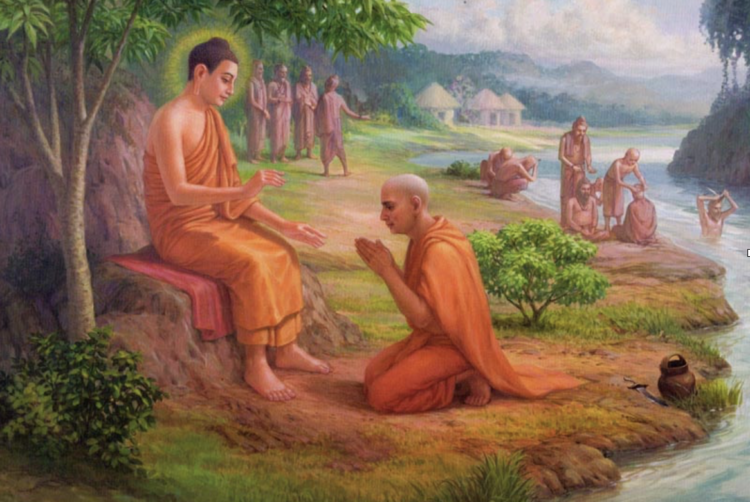The Origins of Christianity, part 15
by Revilo P. Oliver
BUDDHISM
GAUTAMA, who was later called the Buddha (“enlightener”), is said to have been an Aryan princeling in the part of India that lies at the foot of the Himalayas and is now called Nepal. He is reported to have had the distinctive mental trait that makes us distressed by the sight of suffering and sorrow – a racial characteristic that may become a morbid sentimentality in persons who do not charge their reason with strict surveillance of their emotions. In the late sixth century B.C., he elaborated a profoundly pessimistic and atheist philosophy that was, in many ways, strikingly similar to the modern systems of Schopenhauer and Hartmann.(1) It was essentially a repudiation of religion, denying the supposed dichotomy between matter and spirit on which is based belief in the efficacy of worship, prayers, sacrifices, and austerities. He thus negated the claims of the professional holy men, the Brahmins, to power and superiority, thus in effect abolishing the social structure of four primary castes, in which the fakirs had placed themselves at the top.(2) Gautama also denied the traditional values of Aryan warriors and the ruling class to which he belonged; he saw them as vain and futile in the light of the terrible truth that what is best for man is never to have been born.
In an age of lost illusions, when the old beliefs of Aryan man were crumbling under the impact of more exact knowledge and rational criticism, and in an age of political frustration, when many Aryans must have felt themselves mired in the ordure of a multi-racial society, Gautama’s counsel of despair must have appealed to many thoughtful men, but it could never have charmed the masses. It had a social value that must have been recognized by many rulers and administrators, who must have been pleased to see thus checked the impudent pretenses and parasitism of the holy men, and who must have welcomed an ethical system which, by deprecating all human desires and ambitions, cancelled the motives of every form of violence and crime.
Gautama’s philosophy, perhaps inevitably, fell into the hands of votaries, whose minds were more emotional than logical; of professors, who began to quibble about details and argue about definitions and interpretations, making what had been logically simple and lucid obscure and complex; of popularizers, who in turn began to simplify and distort to gain the assent of the commonalty; and of social reformers, who recognized an avenue to influence and emoluments. Buddhism was finally ruined by its success. The great Emperor Asoka, after brilliant conquests, became a pacifist and a Buddhist around 260 B.C., and although he regarded the philosophy as an ethical doctrine, he made it the official religion, using the resources of his vast empire for works of charity, endowing schools, hospitals, monasteries, and hospices for the convenience of travellers, and erecting stupas to mark the sites made holy by some legendary association with Gautama or his early disciples. He sent out missionaries to preach the new Salvation to all the world, including, according to his inscriptions, the lands around the eastern Mediterranean, which were all ruled by Greek dynasties.
The atheistic philosophy was converted into a religion, and it is a nice irony that Asoka, before his death, had to convene a Council of Buddhist luminaries in the vain hope of reconciling doctrinal differences. Gautama was converted into a Saviour, complete, of course, with an immaculate conception and virgin birth,(3) and tales of how he had resisted the temptations of an evil god, who had vainly tried to avert the salvation of mankind. What had been a philosophical principle that we must divest ourselves of all property to free ourselves from the illusion that life is worthwhile became a doctrine of salubrious poverty that spawned hordes of monks, assembled in huge monasteries, and of itinerant mendicants whom we may call friars by a valid analogy. What had been an attempt to establish truths by logic became a system of unreasoning Faith (bhakti) and the spring of orgiastic emotions. The religion was equipped with all the grotesque paraphernalia of superstition, including immortal souls, gods, devils, heavens, hells, miracles, prayers and other magic spells, relics, and hierarchies of priests absorbed in the business of vending holiness to suckers who craved absolution from the sins they confessed – which were many, since some professionals had classified sins under 250 rubrics! And, naturally, the religion became a chaos of competing sects, each vending the only True Gospel, and collectively providing a spectrum of human folly, a wilderness in which one may find almost any variety of bizarre, belief.(4) For example, although Buddhism in general admits women and has nuns as well as monks, and some of the sects even recognize a number of female Saviours, the religion, like Christianity, regards women with suspicion as potential dangers. That, however, is not true of the Tantric sects, in which some of our addle-pated contemporaries want to see “the highest expressions of Indian mysticism.” These sects hold that males and females are equal, except that women are more equal than men, who must seek sanctity in gynaeolatry carried to what some may think extreme lengths. One of their gospels, the Candamaharosana, for example, informs us that “Buddhahood resides in vulva.”
We may be certain that if poor Gautama had indeed had powers of prophetic foresight, he would have sworn himself to perpetual silence and kept secret the conclusions to which he had come. He cannot be blamed for the religion that was perpetrated in his name(5) – much less for its pervasive influence on others.
There was a certain Aryan strength in Gautama’s cosmic negation.(6) It requires fortitude to reject life and to believe that all the things that we instinctively prize and desire, such as health, bodily vigor, sexual love, beauty, culture, wealth, learning, intelligence, and even our own individuality are all empty illusions, and that the greatest good is annihilation. It requires even greater fortitude to accept that belief together with its obscure and dubious corollary, which denies us the immediate release of suicide and imposes on us the painful necessity of dragging out an existence in which we reject everything that healthy men desire and for which they live. That is to endure a death in life. Whether there is truth in that cosmic negation is a problem that each man must solve by his own powers of reason, and a problem that only men of great courage will consider at all.
The rejection of life, however, becomes a cowardly evasion when a perverse superstition enjoins it as a means of appeasing or pleasing a god whom we must believe, by an act of faith, to have promised that if we frustrate every instinct of healthy men and women, he will reward us after death with a blissful life of eternal idleness, which, by an even greater miracle, he will somehow prevent from becoming an infinity of boredom. If we abstain from sexual intercourse to avoid inflicting on others the curse of life and all its miseries, we are behaving rationally and even nobly, if the premise is correct; but if we frustrate our normal desires to please the caprice of a god who presumably endowed us with our instincts to inflict on us the pain of frustrating them to avoid being tortured by him eternally – a god, moreover, who is not even generous enough to help mankind to a speedy extinction, but wants it to reproduce itself and to preserve even its tares and monsters to provide his consecrated dervishes with plenty of business – we have become the cringing slaves of a mad master. If we declare that the manifest differences between races and between the individuals of every race become, for all practical purposes, infinitesimal in comparison with the vast futility of all human life, we are affirming a hope for the annihilation of all species of anthropoids capable of suffering or even of all species of animals that have sentient life; but if we believe that equality is enjoined by a god who so desires a mindless faith that he cherishes idiots and wants us to destroy every form of superiority except clerical wiles, we are simply contriving suicide for our race and a living hell for our descendants.
The Buddhist religion consummated the ruin of India by abrogating the caste system so long as it was dominant, but we are here concerned only with the aspects of the superstition that were contributed to Christianity.
Gautama’s philosophical argument for not reproducing our species was debased into a notion that complete celibacy and total abstention from sexual intercourse was in itself righteous and meritorious, generating the “spiritual values” that are part of all holy men’s stock in trade. His depreciation of all forms of property as representing and stimulating the will to live that must be stifled before it creates more misery was parodied in a notion that poverty was in itself a proof of spiritual superiority. The union of the two notions naturally spawned a horde of religious mendicants, whose supposed sanctity entitled them to live at the expense of their spiritual inferiors, who were so gross that they earned their own living and engendered children to support the next generation of pious beggars.
Originally, the Buddhist bhiksu was a man who, having “slain the five senses” and destroyed in himself “the illusion of individuality,” divested himself of all property except a distinctive mantle of coarse cloth dyed to a dark Turkey red (kasaya, later changed to show sectarian differences), a bowl in which to collect the food he begged, and a staff, and then, having shaved all hair from his body, he began a perpetually itinerant life (pravrajya). The mendicant friars found or were given for shelter at night huts (viharas), which, however, eventually became monasteries endowed by the pious, elaborate and wealthy establishments that provided such ease and comfort that their bhiksus forgot to continue their peregrinations and can more properly be described as monks, although Buddhism did not make the Christians’ sharp distinction between mendicant friars and cloistered monks.
Buddhism was already waning in India when Hsüan Tsang made his pilgrimage to the land in which his religion had been born, but he found 10,000 viharas in Bengal alone; some of these were, no doubt, fairly small and simple buildings, but some were huge edifices that each accommodated more than a thousand ascetics.
The Buddhist ascetic, having “slain his five senses,” had to keep them dead, and for that reason he was forbidden to touch a human being, least of all a woman. In one of the finest of the Sanskrit dramas, a Buddhist friar comes upon a woman who has been strangled and left for dead. He can, of course, pour water on her and fan her to revive her, but when he assists her to arise, she must grasp a vine that he holds out to her.
While it flourished in India, Buddhism was not fanatical, and its monasticism was therefore more humane (and perhaps less corrupt) than the Christian version, for the bhiksu was never bound by irrevocable vows. I cannot forbear to mention Bhartrihari, one of the most charming (and least translatable) of the lyric poets in Sanskrit. As his verses show, he was an elegant and polished gentleman who indulged with refinement in all sensual pleasures until satiety brought a craving for tranquillity and leisure for meditation. He is said to have oscillated between the royal court and a Buddhist monastery, and finally to have become so aware of his own fickleness that when he renounced the world once more and entered a monastery, he ordered his coachman to wait outside. His conduct was doubtless thought bizarre, but it illustrates the humanity that Buddhism never lost in India. There could have been there no parallel to the tragedy of Martha Dickinson’s “Father Amatus, cloistered young.” As the Buddhist institution was carried westward and imitated by Semites, it naturally acquired a savage fanaticism that was transmitted to Christianity.
TAPAS
BEFORE LEAVING INDIA, we should perhaps mention another element that is sometimes thought to have had an influence on Christianity.
Ayrans (and some other races, notably the American Indians) instinctively admired the spiritual strength and fortitude of men wh can bear intense physical pain without flinching and without yielding to the normal physical reactions. The ability stoically to endure pain always arouses admiration, but it can usually be exhibited only in some worthwhile undertaking, such as war or comparable situations, as, for example, by the justly famous and honored C. Mucius Scaevola. In post-Vedic India, however, admiration for such fortitude was distorted into the doctrine of tapas, the belief that by simply enduring pain inflicted upon himself a man automatically acquired a spiritual (i.e., supernatural) power. We should particularly note that tapas produces such power by a kind of natural law, which operates independently of the wishes of the gods and is not in any way affected by the motives of the man who practices the austerities.
The power of tapas is illustrated by the story that is exquisitely retold by Lafcadio Hearn in his Stray Leaves: Two evil princes, determined to obtain ascendancy over even the Thirty-three Gods, practice austerities on a mountain top, remaining absolutely motionless, standing on their great toes only, and keeping their eyes fixed upon the Sun. After many years their self-mortification gave them such divine power that the weight of their thoughts shook the lands, as by an earthquake, and the mountain smoked with their holiness. They were thus able to destroy cities and make deserts of populous lands. (The world and the gods were saved only by the creation of Tilottama, the most beautiful of all women.)
NOTES
1. If we assume that Gautama formulated a logically coherent philosophy, such as the Aryan mentality demands, his doctrine may be reconstructed with some confidence from the Milinda-panha (which purports to be a dialogue between a Buddhist sage and Menander, the Greek King of Bactria and the Punjab, c. 140 B.C.; translated by Rhys Davids in Volumes; XXXV and XXXVI of the well-known series, “Sacred Books of the East,” Oxford,1890-94) and the canonical sutras (pronouncements attributed to Gautama) that do not contradict one another. I shall try to state it as concisely as possible.
The phenomenal world is a succession of empty phantasmagoria, for nothing in the universe is permanent. The world is change, and the discreteness of things and events is an illusory appearance produced in the mind of the spectator. Thus causality is a fiction, for cause and effect are inseparable parts of a continuous mutation. And man himself, for all his vain pride in his own personality, is likewise a mental fiction, for he too is an unremitting mutation: Omnia mutantur, nos et mutamur in illis. All life, consciousness, experience is pain; this world of ceaselessly changing phenomena is a gloomy labyrinth in whose blind mazes a trapped humanity wanders, to be devoured endlessly, again and again, by the Minotaur of suffering and death. The clue to this labyrinth is knowledge, for humanity, blinded by the evanescent and insubstantial phantasms of pleasure and hope, is the victim, not of circumstances or destiny, but of its own will-to-live, its ignorant desire for life. Since the soul is merely awareness of a flux of phenomena at a given instant, there obviously can be no reincarnation of an individual, but Buddhism assumes, although it nowhere clearly explains, that the will-to-live is an unconscious force which, as in Schopenhauer’s philosophy, may undergo a certain palingenesis and thus engender new being. Suicide, therefore, would be self-defeating, since a desire for death is simply an inversion of a desire for life, and that desire will, paradoxically, by palingenesis give rise to another flux of sensations. It follows that the highest wisdom is to destroy in mankind this dread force, the primordially blind and baleful will that produces life and all its manifold misery. And when the last member of our wretched species dies, then shall mankind cease from troubling; then shall the Earth be at peace at last.
Gautama’s psychology and epistemology are certain. There is nothing in the documents that corresponds to my last sentence, which will have reminded the reader of Flammarion’s manly acceptance of an inevitable future in which a frozen and lifeless Earth will still circle sluggishly in the gloaming around a dying Sun. But that last sentence is surely implied by (a) Gautama’s belief that his doctrine is for all mankind and (b) his insistence on the avoidance of all sexual relations and hence, of course, of reproduction.
What Gautama meant by nirvana has been endlessly debated in India and in our time. The word obviously means what happens to the flame when a lamp is blown out. I think it simply means ‘annihilation,’ as Western scholars once agreed in taking it to mean. The religious sects claimed that it meant only the extinction of desire in our minds, and since the horrendous mass of religious texts in Pali and Sanskrit was, in large part, edited and published, many scholars – doubtless the majority – came to agree with them.
2. We do not know how fully the caste system was developed in Gautama’s time nor can we estimate how strictly it was enforced in the numerous states of India, which doubtless differed greatly among themselves, but it is certain that the Brahmins everywhere asserted their monopoly of religious rites and hence their right to live at the expense of others, as holy men always do. We should not underestimate this aspect of early Buddhism: The doctrine that all human beings were equal in the universal wretchedness of mankind had the deplorable effect of destroying such sense of racial cohesion as the Aryans had left, but that was, so to speak, the price paid for breaking the clergy’s strangle-hold on society.
3. There are a few slight variations in the standard story about virgin births. The Buddha’s mother, Maha Maya (“The Great Illusion”!), a wife who had remained a virgin until she was forty-five, was impregnated by a “reflection” cast on Earth by his celestial father, and she bore the divine child by a kind of miraculous Caesarian section, for he burst through the side of her abdomen, which was then instantly healed. The precocious infant at once announced that he had come to save the world from the devils, and he took seven long steps towards each of the four cardinal points to show that he was going to save all mankind. He was an old hand at the salvation-business, for that was his five-hundredth incarnation on Earth, and the Buddhists soon started scribbling jatakas as facilely as the Christians later composed tales by martyrs and other wonderments. The jatakas were the true histories of the earlier incarnations of Gautama or other Buddhas. Buddhists, however, as befits Orientals, are more patient than Christians: The final salvation of mankind will be accomplished by a Buddha who will appear, in terms of our calendar, in 5,655,524 A.D.
4. What happened, of course, was that all the superstitions spawned in a multi-racial society were imported into the new religion, with a few clever theological twists and adaptations and some additions. It would be otiose to go into the complex details. One thing is certain, that holy men believe that unemployment in their business would be very bad for society, and they always find means of averting it.
5. I cannot call to mind a volume that covers all the varieties of Buddhism and its very numerous sects, past and present, but an adequate outline of the principal tendencies in the religion may be found concisely in the English version of Maurice Percheron’s Buddha and Buddhism (London, Longmans, Green, 1957). I have noted that his sympathy with the religion did not prevent him from admitting at one point (p.40) that Gautama’s doctrine was quite different, a briar that did not bear the fragrant roses of “spiritual” superstitions.
6. It is true that the distinctively Aryan spirit is a strong affirmation of life, a determination to live to the utmost, “to live, though in pain,” and to be undaunted by suffering and sorrow – to confront tragedy unafraid. It is the high code of aristocratic honor that makes Achilles choose valiant deeds and an early death, that makes the Viking hero go to his doom in this world as unflinchingly as his gods will fight their last battle in the foreordained Götterdammerung. “The honorable end is the one thing that can not be taken from a man,” said Spengler. And Nietzsche summarized the Aryan code in one sentence: “To die proudly when it is no longer possible to live proudly.” For the essence of this code, so much hated by Christians, is the aristocrat’s pride in his own self-mastery and indomitable will: it makes Gunnar defiant to the end, even in the snake-pit, and appears in Byron’s Manfred: “He mastereth himself, and makes / His torture tributary to his will.” Note, however, that the aristocrat’s pride is in the integrity of his own personality. If he were convinced by Gautama’s psychology, which so markedly resembles modern theories of a “labile psyche,” he would refuse to be only a flux of sensations, and would be numbered among those of whom Glanvill said, “Certainly, could they have been put to their choice whether they would have come into being upon such terms, they would rather have been nothing forever.” And, by the way, the state of being nothing, of being like the light of an extinguished lamp, is precisely what Gautama meant by nirvana.
To be continued
* * *
Source: revilo-oliver.com







The great Dr Oliver is a bit weak here, reading Hindu reformer Buddha thru his Western agnostic ideas – see by contrast, right-wing India scholar Koenraad Elst. Buddha’s simplified route to reincarnation-escape Godhood swept India, tho Buddhist passivity enabled Muslim conquest, leading Buddhists elswhere to be more militant. India’s pushback of Islam via recovering native warrior-Hindu religiosity, is an important ethnic story. And one might note as well here what gays themselves say – celibacy, monks, etc, worldwide, was always a cover for gays.
Maybe Buddhism is negative, but it was a supreme Buddhist leader, the Dalai Lama, who declared that Europe should be for Europeans. That sounds positive and life-affirming to me.
The Dalai Lama can give his opinion on anything he wants, but I believe it is the strength of a people that determines what territory they will conquer and hold. If we Whites are to be dominant and exclusive anywhere, we need to prove it with well-led, intelligent, and organized action. Join us: http://www.natall.com/about/what-is-the-national-alliance/
If I am to join you, you must immediately stop this nonsense that my great-great-great-etc. grandfather was a black African. The shame of it!
In all the cosmos, all are a part of the whole. We’re related to space dust too, it’s simply that we Whites have evolved farther than that dust…or feral congoids. Being ashamed of the knowledge that all are interconnected in some way doesn’t make much sense to me.